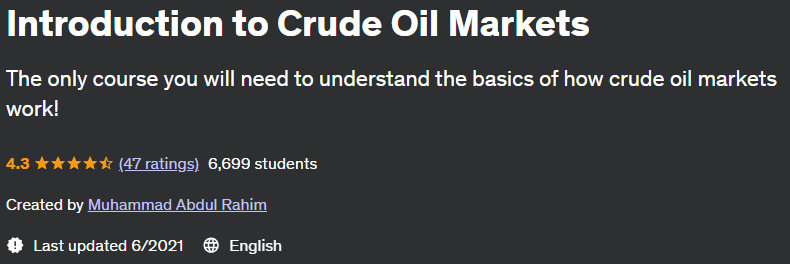
Description
Introduction to Crude Oil Markets course. Course 01: Introduction to Petroleum: This course provides an overview of all the topics we will cover in this course. We will begin by describing the oil value chain – exploration and development, how oil is produced, transported and marketed. In the following, we will learn about the importance of oil in the industry, both as a fuel and as a raw material in various forms in the global economy. Next, we’ll review a brief history of oil—how it all began and the “types” of oil explorers. We will get to know the main players in the oil market – top producers and major consumers. Then we will see how oil is formed, how it gets deep underground, and how we discover and refine it. We will learn about the different types of oils and the methods used to extract them. In the following, a brief overview of the various means of transporting oil, and the risks and benefits associated with different methods of transporting oil, will be presented. Finally, we will look at the various oil benchmarks that prevail globally.
Course 02: Access, Leasing and Exploration: This course focuses on the first step in setting up an oil well – including obtaining access and lease rights. The reading begins with an overview of the legal process and the various steps involved in the development of an oil project. There is a brief discussion of oil and gas formation and how subsurface geological structures affect oil and gas production. We also look at the legal aspects of land exploration (for oil and gas), as well as access to mineral rights, under different types of financing regimes. This is followed by an overview of the components of a lease agreement, common transaction terms, and methods used to establish royalty payments. This study also explains the characteristics and different classifications of reserves. Finally, the study concludes with a brief discussion of the ratio of stock substitution and stock-to-production.
Course 03: Oil and Gas Project Development: This chapter focuses on project development and risk and return assessment of oil and gas projects. We begin with an overview of the various stages involved in the decision-making and project development processes, illustrated through a case study, and discuss the upstream project development stages and associated risk elements. This study then explains the concept of unitization and creation of joint development areas. This with calculations and interpretations of criteria
Project economics such as NPV, IRR, WACC and risk adjusted returns are followed. The reading describes the potential risks associated with the use of contractors and subcontractors in petroleum projects. Various contractor relationships and their environmental and socio-economic impact along with safety risk issues are also discussed here. Finally, we conclude by identifying and calculating the key elements of cash flow in an oil project and their determinants – capital investment, well price, gross revenue and operating costs, as well as simple royalties and tax payments, again explained with the help of a case study. .
Course 04: Production of Oil and Gas Products: This study focuses on management challenges in oil and gas production with an emphasis on cost efficiency and cost advantage. The study begins by examining the various costs in the upstream sector, and how they are calculated, their impact on a company’s revenue, and how production costs vary by location. The study then looks at the economics of oil using various parameters such as operating profitability, break-even, operating profit and taxation. The study then moves to strategic cost management and examines various cost drivers and their impact on specific costs. It then discusses the effect of economies of scale, economies of scope, and the learning curve on production costs. Then it discusses and separates the primary, secondary and tertiary methods of oil recovery. The study then evaluates the terms and conditions of a partnership management agreement and explains how tasks are shared and disputes between the various parties involved are resolved. Read more about contractor supply chain management and the various contractor needs that different stakeholders in the oil and gas industry have.
Chapter 05: Transportation and Storage of Petroleum: This study explains the logistics of transportation of crude oil and other refined products. The reading begins with oil tankers – how they are classified by type and size and their transport characteristics. Then it goes to the types of common charter contracts used to transport oil and their characteristics, followed by an introduction to the Worldscale pricing system and how to calculate the cost of an oil shipment using it. The study then explains the relative economics associated with different methods of oil transportation and explains how pipeline transit times and unexpected disruptions in transportation can affect commodity traders and oil consumers. The following is a description of the types of crude oil storage facilities and an explanation of how to generate storage level reports. Finally, this study discusses the content and use of primary inventory storage reports produced by various agencies.
Course 06: Petroleum Pipeline Operations: This course describes the petroleum transportation system, focusing primarily on petroleum pipelines – both crude and refined. This study begins with a brief introduction of oil pipelines and their types. It then explains the field operations of the pipeline (receiving and delivering crude oil and refined products) and the operations of the central control room. The study then explains key aspects of pipeline operations planning and scheduling, including the role of personnel, batching, pressure and transfer. Finally, reading identifies and explains normal and abnormal operations.
Course 07: Investment Decisions (Oil Pipelines): This study answers questions about how and why pipelines are built and who decides to build them. It addresses all the different stakeholders involved in the decision-making process and how they affect the economics of pipeline construction. It then goes on to explain the factors that motivate buyers and sellers to change ownership of pipelines. Finally, the study discusses what determines the selling price of pipelines and the various methods used to value pipeline costs.
What you will learn in the Introduction to Crude Oil Markets course
-
A detailed overview of how crude oil markets work
-
How oil and gas companies access oil and gas reserves
-
How to develop oil and gas reserves
-
How is crude oil produced?
-
How crude oil is transferred from upstream to downstream
-
How do oil pipelines work?
-
How are investment decisions (regarding oil pipelines) made?
This course is suitable for people who
- Beginner students who are interested in understanding how crude oil markets work
- Educators who wish to develop a deeper understanding of how crude oil markets work
- Energy Risk Professional Candidates (GARP).
- Financial analysts who want to understand the oil and gas industry because they need to evaluate and value oil and gas companies.
- Accountants working or aspiring to work in oil and gas companies
Details of the Introduction to Crude Oil Markets course
- Publisher: Udemy
- teacher: Muhammad Abdul Rahim
- Training level: beginner to advanced
- Training duration: 7 hours and 18 minutes
- Number of courses: 69
Course headings
Prerequisites of the Introduction to Crude Oil Markets course
- Be able to read and understand English language
Course images
Sample video of the course
Installation guide
After Extract, view with your favorite Player.
Subtitle: None
Quality: 720p
download link
File(s) password: www.downloadly.ir
Size
2.2 GB

Be the first to comment